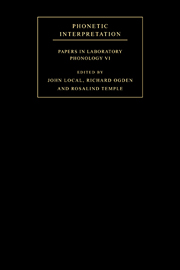Book contents
- Frontmatter
- Contents
- List of contributors
- Acknowledgements
- Introduction
- Part I Phonological representations and the lexicon
- 1 Interpreting ‘phonetic interpretation’ over the lexicon
- 2 Effects on word recognition of syllable-onset cues to syllable-coda voicing
- 3 Speech perception, well-formedness and the statistics of the lexicon
- 4 Factors of lexical competition in vowel articulation
- 5 Commentary: probability, detail and experience
- Part II Phonetic interpretation and phrasal structure
- Part III Phonetic interpretation and syllable structure
- Part IV Phonology and natural speech production: tasks, contrasts and explanations
- References
- Index of names
- Index of subjects
2 - Effects on word recognition of syllable-onset cues to syllable-coda voicing
Published online by Cambridge University Press: 22 September 2009
- Frontmatter
- Contents
- List of contributors
- Acknowledgements
- Introduction
- Part I Phonological representations and the lexicon
- 1 Interpreting ‘phonetic interpretation’ over the lexicon
- 2 Effects on word recognition of syllable-onset cues to syllable-coda voicing
- 3 Speech perception, well-formedness and the statistics of the lexicon
- 4 Factors of lexical competition in vowel articulation
- 5 Commentary: probability, detail and experience
- Part II Phonetic interpretation and phrasal structure
- Part III Phonetic interpretation and syllable structure
- Part IV Phonology and natural speech production: tasks, contrasts and explanations
- References
- Index of names
- Index of subjects
Summary
Introduction
It is well known that syllables in many languages have longer vowels when their codas are voiced rather than voiceless (for English, cf. Jones 1972; House and Fairbanks 1953; Peterson and Lehiste 1960; for other languages, including exceptions, see Keating 1985). In English, the durational difference in stressed syllables can be 100 ms or more, and it is well established as one of the strongest perceptual cues to whether the coda is voiced or voiceless (e.g. Denes 1955; Chen 1970; Raphael 1972). More recently, van Santen, Coleman and Randolph (1992) showed for one General American speaker that this coda-dependent durational difference is not restricted to syllabic nuclei, but includes sonorant consonants, while Slater and Coleman (1996) showed that, for a British English speaker, the differences tended to be greatest in a confined region of the syllable, the specific location being determined by the syllable's segmental structure.
In a companion study to the present paper (Nguyen and Hawkins 1998; Hawkins and Nguyen, submitted), we confirmed the existence of the durational difference and showed that it is accompanied by systematic spectral differences in four accents of British English (one speaker per accent). For three speakers/accents, F2 frequency and the spectral centre of gravity (COG) in the /l/ were lower before voiced compared with voiceless codas, as illustrated in Figure 2.1. (The fourth speaker, not discussed further here, had a different pattern, consistent with the fact that his accent realises the /l/-/r/ contrast differently.)
- Type
- Chapter
- Information
- Phonetic InterpretationPapers in Laboratory Phonology VI, pp. 38 - 57Publisher: Cambridge University PressPrint publication year: 2004

